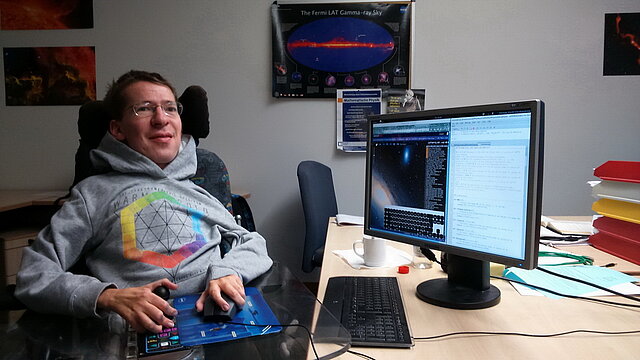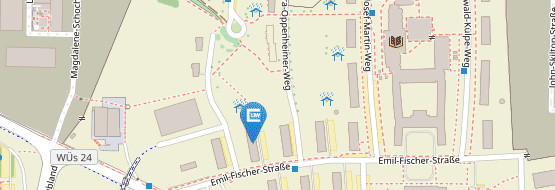Dr. Christoph Wendel
Postdoc
Email: christoph.wendel@uni-wuerzburg.de
Room: 31.02.012

My field of interest focuses on electromagnetic cascades in astrophysical environments. In such cascades photons, electrons and positrons interact repeatedly through a number of radiative processes (synchrotron radiation, inverse-Compton scattering, pair production). By this, gamma rays and elementary particles can be generated. In my research, I consider how accelerated particles and intrinsic gamma-ray spectra are influenced and reprocessed via cascading on background photon fields (like e.g. the cosmic microwave background, the extragalactic background light, accretion-flow spectra, thermal spectra, emission-line spectra). The spectra emerging from the source can obtain peculiar, observable imprints. Based on physical models of the study subject, I determine the evolving gamma-ray spectra theoretically by numerically solving kinetic equations and compare the theoretical spectra with observational ones. From this, I can falsify the physical model or parts of it and I can discard, revise or refine the assumptions.

Figure 1: Sketch of a synchrotron inverse-Compton pair cascade. Electrons are injected into the interaction region. They either escape from the region or they interact via inverse-Compton scattering on the soft photons. By this, the electrons lose energy (but they remain in the system), and they up-scatter the soft photons into the gamma-ray regime. Gamma rays are also injected and can escape from the interaction region. By interaction with the soft photons they can also pair produce additional electrons. Another channel for the electron interaction is synchrotron radiation in a magnetic field. By this, on the one hand synchrotron photons are created and replenish the soft-photon field and on the other hand the electrons again lose energy.
Especially, I have applied inverse-Compton pair cascades to pulsars' outer magnetospheric vacuum gaps to assess the relevance of various radiative processes. Furthermore, I inspect cascades near the base of relativistic jets in active galactic nuclei to provide an explanation for narrow, transient features in their spectral energy distribution.
Feel free to contact me, for comments or questions concerning my research or for discussions about astrophysics and the universe!
Personal statement on diversity, equity and sustainability:
I appreciate all the multifaceted phenomena of nature as well as the diversity that developed during the evolution of the universe. Thus, I show solidarity with people that have historically been or still are discriminated, oppressed or underrepresented. I support their rights to freedom of expression and participation and fair treatment.
I recognise the scientific evidence for the cause of the recent climate change of Earth being of anthropogenic nature. I also recognise the ensuing threatening to the terrestrial biosphere as well as to the human civilisation. Consequently, I support measures, as far as possible under the law, to reduce greenhouse gas emission and other environmental damages.
Together with Prof. Dr. Matthias Kadler, I coordinate the activities of the DFG research unit 5195 "Relativistic Jets in Active Galaxies"
This research unit brings together experts in theory, modelling, observation and interpretation of all relevant aspects of jet physics to provide answers to questions on jet launching, jet powering, acceleration, collimation, propagation and termination as well as on the radiative and dynamic processes thereby.
- My ORCID profile
- Poster for the Franconian Astronomers Neighborhood Collaboration Incentive (2021)
- Contributed talk at the International Cosmic Ray Conference (2021)
- Contributed talk at the conference "Extragalactic jets on all scales - launching, propagation, termination" (2021)
- Talk for the spring meeting of the Deutsche Physikalische Gesellschaft (2018)
- Poster for the 6th International Symposium on High-Energy Gamma-Ray Astronomy (2016)
- Talk at the annual conference of the Astronomische Gesellschaft (2013)
- Project paper on synchrotron emission of the Crab Nebula (2011)
- Project paper (in German) on the supernova cosmology project (2010)
- Generally understandable talk in German, plain language for the interested publicity about astrophysical research in general and about my personal contribution
- 2022: Graduation as Dr. rer. nat. (PhD) at Julius-Maximilians-Universität Würzburg, Germany (Thesis: Spectral Imprints from Electromagnetic Cascades in Blazar Jets)
- 2013: Graduation as Diplom-physicist at Julius-Maximilians-Universität Würzburg, Germany (Thesis: Determining the Gamma-Ray Spectrum of the Crab Pulsar through an Outer Gap Model)
- 2006: Abitur graduation at Deutschhaus-Gymnasium Würzburg, Germany
- Numerical implementation of radiative processes
- Synchro-curvature radiation
- Inverse-Compton scattering
- Pair production
- Elastic photon-photon scattering
- Python programming


